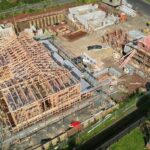First multigenerational state built home community now game-changer

LONDON: It’s the first of its kind – five new state homes, built purposely for multigenerational living, with Pacific people in mind.
The project, on a 2000-square-metre site, is at Red Hills in Auckland’s Papakura, and has been earmarked to tackle overcrowding and transform the housing market.
The three- to six-bedroom, two-storey homes were designed by Pacific architects and are fit for Pacific purpose – designed with extra size and circulation.
There are bedrooms, bathrooms and living spaces on all floors, and three of the homes are wheelchair accessible.
The landscape presents edible gardens and a fale to encourage community living.
It’s being built by Penina Trust, the only Pacific social housing provider in New Zealand.
Project manager Paul Miller from PJM Projects said even the garages are bigger, and can be used as a fifth bedroom or another communal area, if needed.
“The entry in and out of the house has been made bigger, and we lined the garage out so that it effectively doubles up as a rumpus room or utility room, in recognition of celebrations or funerals for large gatherings,” Miller said.
“We put bedrooms on all levels, recognising that you may have the grandparents or family downstairs. The rooms are larger, recognising that kids may have sets of bunks instead of a single bed in it, so there will be more than one person in a room.
“The master bedrooms are larger, you may have mum and dad, and a child in a cot.”
It’s set to be completed in 2023, but there are plans of more to come.
“This project has a soul, so it has a higher, greater purpose. You’re not punching out affordable housing just for the sake of affordable housing.
“From its inception, the project was designed with Pasifika people in mind, it was designed not as a pure development where you would want to maximise the number of houses on the site.”
Penina Trust chairman Soane Foliaki said building intergenerational homes fit for Pacific people was important.
“We put our hand up to help assist alleviate the housing shortage, particularly for our people because we are at the lowest part of the economic ladder,” Foliaki said.
“All our new developments are designed to cater for large Pacific families.”
He said there’s already a long list of applicants waiting to make the homes their own.
The project is part of the Government’s Fale mo Aiga: Pacific Housing Strategy and Action Plan 2030, a response to the housing challenges faced by Pacific people in Aotearoa.
According to the Ministry of Pacific Peoples, Pacific people are disproportionately affected by the housing crisis, experiencing some of the worst housing outcomes of any population in the country.
Loisi* knows this only too well.
The Auckland resident has been struggling to find a proper home for her large 10-member family. She’s spent years renting, often cramped in Auckland homes, because nothing they found was big enough to fit them.
“I remember one time we had to lie about the number of people living with us when we applied for a rental. The western world don’t understand that it’s in our culture to look after everyone,” she said.
“I have my grandparents, my parents, my children, and sometimes we have nieces and nephews that come and stay for a bit before they move on – we’re a large family.
“It’s been hard looking and finding a place that fits us all.”
The goal was to buy a house – she said five of the people in her home all had full-time jobs and were contributing to this dream.
“I want my children to grow up with their grandparents, with my grandparents. It takes a village to raise a kid and that’s so true for Pasifika. We do not leave anyone behind.”
Ministry of Pacific Peoples deputy secretary Aiono Matthew Aileone would love to see more housing fit for Pacific people.
Aileone knows what he’s talking about, with a building background having worked for the Master Builders Association.
The old New Zealand housing stock was dominated by eurocentric-designed three-bedroom standalone homes, often not suited for New Zealand conditions, he said.
“When it comes to Pacific [people], the dynamic there is that especially families that have elderly or matua (elder) tend to live in multigenerational arrangements just because of the emphasis on some Pacific values which put a lot of focus on supporting each other.”
In Pacific cultures, staying connected to family was important, he said.
A new report on housing and retirement amongst Pacific peoples in Aotearoa revealed better housing solutions and financial education were key to improving the wellbeing of Pacific peoples.
Commissioned by Te Ara Ahunga Ora Retirement Commission, the research looked at Pacific matua (elders) from 18 households, from nine Pacific ethnic backgrounds.
All were living intergenerationally in stand-alone, one roof dwellings, and 11 of them were homeowners. The rest were renting.
Those who were homeowners lived in lower quality housing, with concerns around heating, dampness, and mould.
A matua from Kiribati said the best way to live for Pacific people was to live intergenerationally.
“I like to live with my children and grandchildren, we do not necessarily have to live in the same house but at least we live close to each other.”







